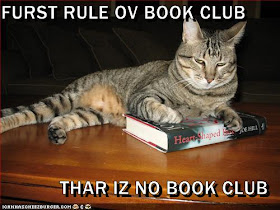* This is part two of Paul's Writing Fantasy post. Part one can be found here: http://cbcatas.blogspot.com/2011/11/writing-fantasy-101-by-paul-collins.html. Now, the journey continues ...
6. TESTS, ALLIES & ENEMIES
The Hero meets difficulties that test his or her strength and commitment. At this point they are usually not huge tests, but they will grow as the journey develops. In the process they will also enlist the help of allies (who may become permanent companions) and they may make enemies. Frodo ─ along with Sam, Pippin and Merry ─ have their first near misses with the dreaded Black Riders and only narrowly escape them. In the process Frodo is strongly tempted to put on the ring, an action that would bring instant doom to him and his companions, but he manages to pass this test. Cinderella’s enemies are her ‘family’, and an unexpected ally is the fairy godmother and prince. Part of her test is not being recognised by her hateful step-mother and step-sisters and in not becoming so caught up in all the wonder and riches of the Ball that she forgets the time. Harry’s news friends are Ron and Hermione; his enemies are Malfoy, Goyle and Crabbe ─ although these are underlings to Harry’s main foe, Lord Voldemort. His tests are many: the sorting hat, moving stairways, Quidditch. Dorothy makes friends with the Scarecrow and Tinman, and later the lion and learns of the Wicked Witch. Jelindel survives various dangers and adversaries, learns more about her companions, becoming friends to some extent, and finds the map to the other links.
This is also the section where we start to learn about the Hero (and their companions and adversaries) by seeing how they deal with the challenges and tests (such as the fights and negotiations in the cantina in Star Wars). This section may take up a large part of the book or the film.
7. APPROACH TO THE INMOST CAVE
The Hero approaches the most dangerous place in the story (keep in mind that this sequence of crossing a threshold, undergoing tests, making allies and enemies, and approaching a very dangerous place may be run over and over again, each time increasing in deadliness and difficulty). The hero makes plans or preparations here, often girding him or herself for what is ahead. Here Luke approaches the Death Star and Frodo approaches Mordor (this is the biggest and deadliest ‘inmost cave’ in LOTR; there are many others on the way of course). Cinderella is scared to meet the prince, and also scared when she falls in love with him. Harry must study hard, learn to fly a broomstick, and decide whether to break Hogwarts rules. Dorothy and her friends approach the Emerald City. Jelindel must go to the Valley of Clouds and fight paraworld beasts to find the next link. Someone tries to kill her.
8. THE SUPREME ORDEAL
Here the Hero risks death, risks failure, risks losing everything ─ often not just for themselves but for their world as well. It usually also brings the Hero to their lowest darkest moment in the story, when everything appears to be over due to their apparent failure, and they cannot go on. They must give up. But they don’t. However, this is also where the Hero undergoes a real or symbolic death (or ‘shares’ in one, as Elliot does in E.T. when his alien friend dies). This allows the Hero to be reborn, an important part of the mythical story. In LOTR, Frodo and Sam enter Mordor ─ the most dangerous place in Middle Earth ─ and Frodo ‘dies’ after being stung by the great spider, Shelob. He is then reborn in time to carry out the final part of the quest. Cinderella must escape from the ball before she turns back to her former self. Harry must defeat the fearsome troll, and partake in his first Quidditch match. Dorothy has to confront the Wicked Witch, enraged at the loss of her ruby slippers. Jelindel faces a paraworld beast much more powerful than she is and one who is intent on killing her. She nearly dies. A demon saves her life.
9. REWARD (SEIZING THE SWORD)
The Hero ─ through bravery, loyalty and determination ─ wins through and obtains the treasure, which may be a magical object such as a gem, a sword, a suit of armour, or sometimes special knowledge or power or ─ as in LOTR with a twist on the fairy story ─ is the destruction of the object that is too powerful and too perilous to keep. Cinderella learns that the prince is in love and will marry the woman whose foot fits the lost slipper. Harry is rewarded with Hermione’s friendship and becomes popular when he wins the Quidditch match against Slitherin. After some difficulty, Dorothy persuades the Wizard to grant all their wishes. The demon that saved Jelindel’s life tells her how to use the power of the link without dissipating it. She also finds a flying craft.
By the Hero’s action the world is saved, especially the Ordinary World from where they started.
10. THE ROAD BACK
In many stories the road back is almost as dangerous as the one coming. Sometimes the dark forces chase the Hero for some way as Darth Vader goes after Luke when the Death Star has been destroyed. Frodo’s road back isn’t just the return to the Shire, which is fairly uneventful, but it’s also what happens when he gets there. Cinderella doesn’t think her step-sisters will let the prince anywhere near her and she’ll have to stay in the ordinary world. Harry’s home is now Hogwarts. But he must face a dangerous journey through the Forbidden Forest. Dorothy goes looking for her way back to Kansas when the Wizard’s hot-air balloon takes off with him in it. Jelindel battles Korok, an alien, and his deadly spacecraft. She must then deal with Daretor and Zimak, who pose a threat of another kind.
11. RESURRECTION
Usually there is a final struggle when the Hero returns to the Ordinary World (or is on the border of it). It can be nearly as dark and deadly as what took place in the Supreme Ordeal and can be seen as a smaller version of that challenge. It’s as if darkness has not been fully vanquished yet and whatever residue of it remains in the world is intent on having one last go. Cinderella tries on the glass slipper that fits. She and the prince fall in love. Harry gets past Fluffy, the three-headed dog, and outwits the flying keys and plays a deadly game of wizard chess in order to stop Voldemort getting the philosopher’s stone, but he’s struck down and seems to die. Dorothy’s greatest danger has already passed when she took on the Wicked Witch, but her own symbolic death occurs when she wakes in Kansas from a death-like sleep. Jelindel has one final battle with the almost omnipotent mailshirt entity, and nearly loses, but narrowly manages to stop it winning.
This stage reminds me of horror movies where the heroes embrace one another, say on the boat in Anaconda, after the villain has been knocked on the head and dumped overboard. Just when you think it’s all over, the villain’s hand leaps from the water, he drags himself back on board, and the fight resumes as though the villain never received an injury.
12. RETURN WITH THE ELIXIR/TREASURE
The Hero comes home ─ though ‘home’ may have changed due to what has happened throughout the story and in the resurrection stage. With them, the Hero brings back the treasure, the elixir, the magical device, the special knowledge that is needed, or restores peace (for the time being) as in Star Wars. [The elixir may also be love, freedom, wisdom, etc.] In LOTR, Frodo brings back an ‘absence’ ─ the ring has been destroyed. This absence is symbolised by his missing finger, bitten off by Gollum who then fell into the furnaces of Mount Doom with it. By his struggles Frodo has saved Middle Earth and his beloved Shire, though not for himself and it is a bittersweet ending for him. Cinderella marries her prince and lives happily ever after, no longer a lowly servant. Harry wakes in hospital and is a hero. He now knows that his parents had loved him, and returns ‘home’ with photos of them. Dorothy learns that home is where it always was, in Kansas with her Aunt Em who really does love her. Like Frodo, Jelindel has saved the world from a terrible evil, but at great cost to herself and others. She has lost her family and had to grow up really fast. She cares about her companions but banishes them to a paraworld. It’s the best choice she can make at that time.
In summary:
1) Heroes are introduced in the ORDINARY WORLD, where
2) they receive the CALL TO ADVENTURE
3) They are RELUCTANT at first or REFUSE THE CALL, but
4) are encouraged by a MENTOR (taking on the added role of the HERALD) to
5) CROSS THE FIRST THRESHOLD and enter the Special World where
6) they encounter TESTS, ALLIES AND ENEMIES
7) They APPROACH THE INMOST CAVE, crossing a second threshold
8) where they endure the SUPREME ORDEAL.
9) They take possession of their REWARD and
10) are pursued on THE ROAD BACK to the Ordinary World.
11) They cross the third threshold, experience a RESURRECTION, and are
transformed by the experience.
12) They RETURN WITH THE ELIXIR, a boon or treasure to benefit the
Ordinary World.
Not all of these stages occur in every fantasy novel but they generally appear in this order (even if some are left out). The approach to the inmost cave and the subsequent facing of the ‘supreme’ ordeal is a sequence that occurs several times, growing in significance and danger each time, until the ultimate ‘supreme’ ordeal is reached (it may be worth thinking of the earlier confrontations just as ordeals, though each one is worse than the one before).
Paul’s many books for young people include series such as The Jelindel Chronicles, The Earthborn Wars, The Quentaris Chronicles and The World of Grrym in collaboration with Danny Willis. His latest book is Mole Hunt, book one in The Maximus Black Files. The trailers are available here: http://www.youtube.com/watch?v=3S-eKDYqpEs and http://www.youtube.com/watch?v=n4tTn_WXCiw.
Paul has been the recipient of the A Bertram Chandler, Aurealis, William Atheling and Peter McNamara awards and has been shortlisted for many others including the Speech Pathology, Mary Grant Bruce, Ditmar and Chronos awards.
*Paul will be in Tasmania giving writing workshops during April and May 2012. Email him at fordstr@internode.on.net if you would like him to visit your school or library. www.paulcollins.com.au
 A baby dragon cuddles up with Mum for his favourite going-to-bed story. It's about Cedric, a naughty dragon who annoys trolls and grabs princesses to turn into pies. As soon as the story is told, the baby asks Again! After a third reading Mum is very tired and baby is turning into a Cedric lookalike with incendiary consequences.
A baby dragon cuddles up with Mum for his favourite going-to-bed story. It's about Cedric, a naughty dragon who annoys trolls and grabs princesses to turn into pies. As soon as the story is told, the baby asks Again! After a third reading Mum is very tired and baby is turning into a Cedric lookalike with incendiary consequences.

































